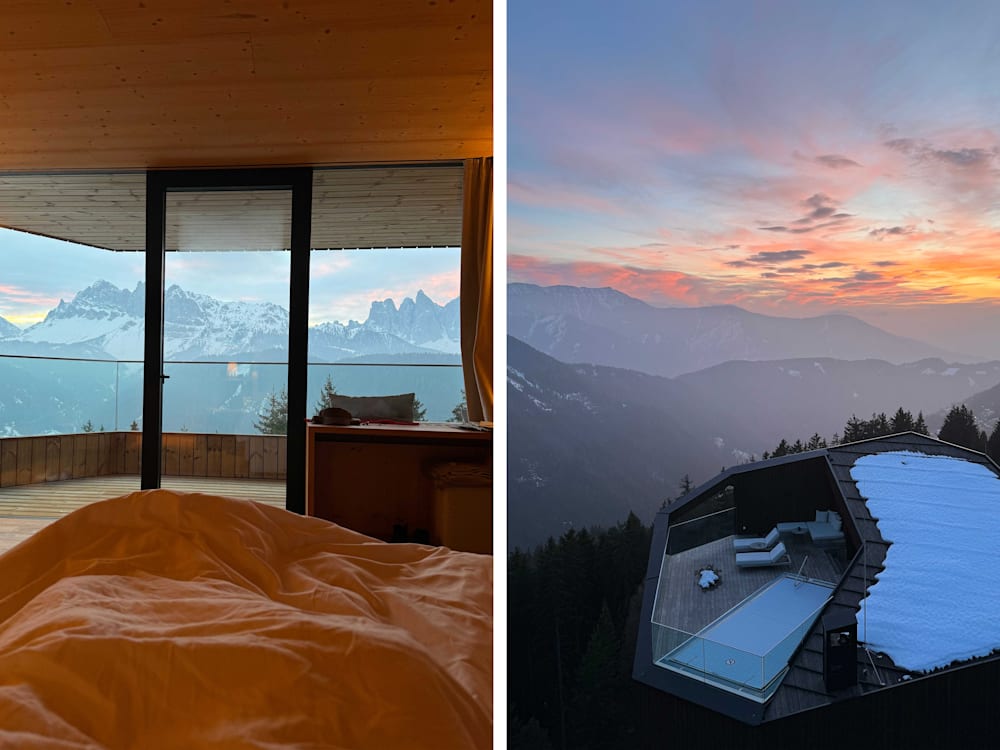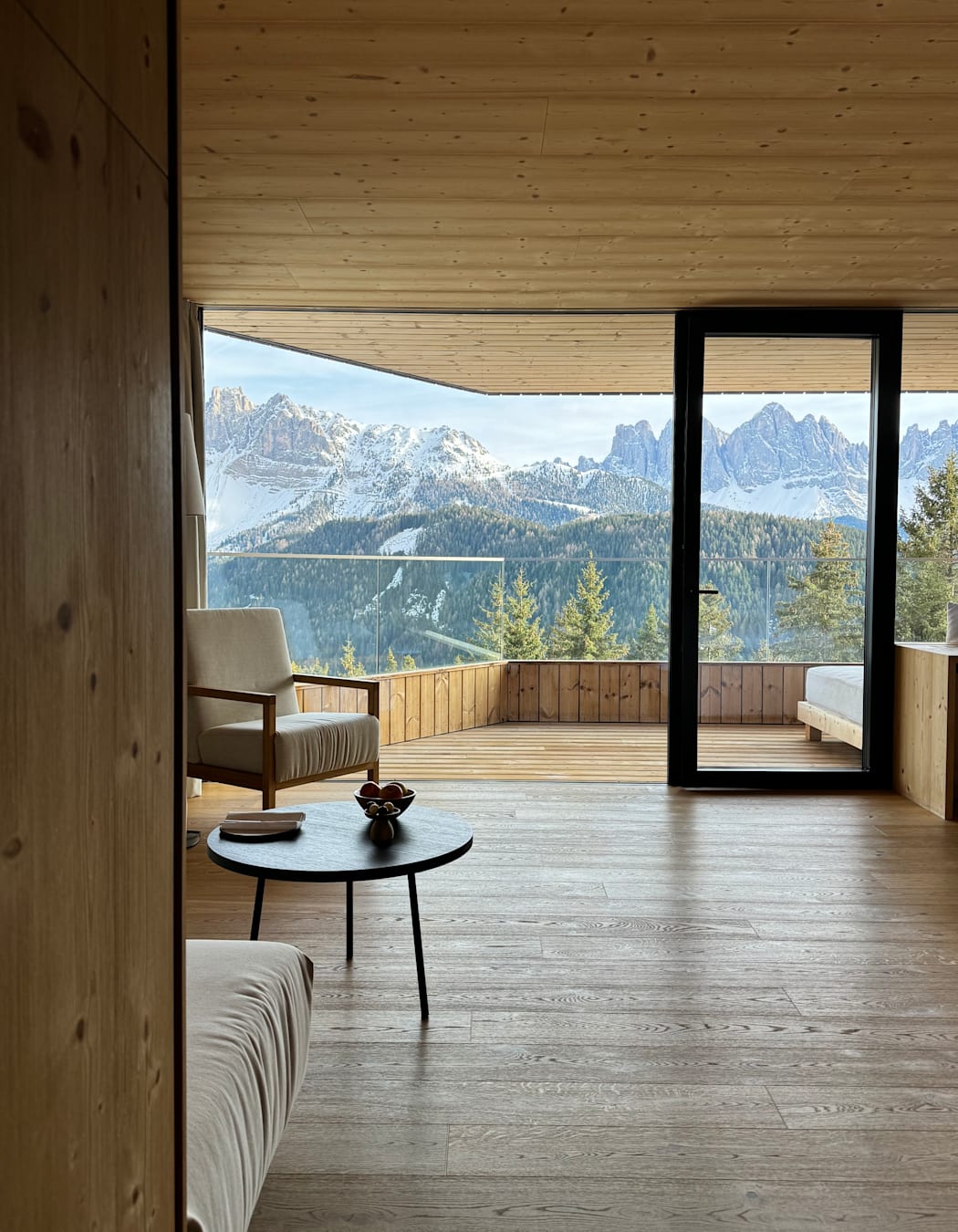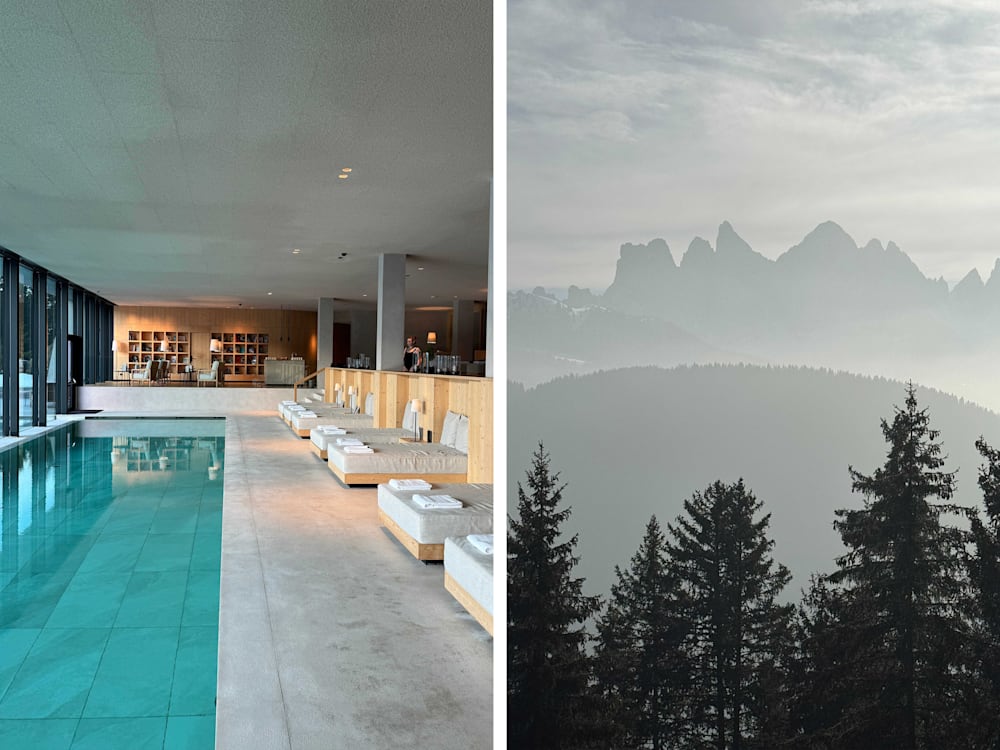For Goethe, the Dolomites were an expression of sublime beauty. Reinhold Messner likened them to art. Le Corbusier described them, simply, as ‘the most beautiful natural architecture in the world’ – he said that God had built them. From where I’m standing – surveying a dawn-lit spread of the ancient massifs – it’s difficult to argue otherwise. Goethe also claimed mountains are ‘silent masters’, and here at Forestis, they’re akin to the divine. Steam curls skyward as I marvel at them from the corner of the outdoor pool, their magnitude underscored by an absence of noise, which heightens the senses, making their crags appear rougher, peaks sharper and colour more intense. For the next few days, I consider myself their pupil.

Unlike the Alps’ round-shouldered caps, the Dolomites are splintered and stoic. They spike the skyline like the candles of an austere birthday cake, marking the passage of time. In their presence, it’s hard not to feel humbled. It’s this combination of existential clarity, monastic silence and lungfuls of fresh, forest air that has drawn health-seeking pilgrims for centuries. It’s the legacy that wellness retreat Forestis is built on. Though never used for its intended purpose, the historic part of the hotel was built by the Austrian monarchy as a tuberculosis sanatorium back in 1912. Intentionally south-facing and constructed using local wood, it’s a rudimentary example of biophilic design, a term coined by biologist Edward O Wilson to describe an architecture which seeks to promote wellbeing by connecting with nature.
Wilson speculated that all humans have an innate affinity to nature; that we’re drawn to certain spatial characteristics for the positive effects they endow on our physical and mental states – an elevated position with a view, for example, the presence of water, natural colours, dynamic lighting and organic shapes. Though he wasn’t the first to observe design’s impact on our wellbeing – the ancient Greeks knew it too. In fact, they based entire cities around it, with sleeping halls and healing centres designed to provide physical and spiritual relief. Likewise, the Romans, with their communal bath houses, understood the importance of light and water. Here at Forestis, however, the inspiration is the Celts, the ancient peoples who once occupied this area – on the southern slope of the Plose mountain near Brixen, South Tyrol – and their deep appreciation for the natural world.

‘We didn’t simply look back a few years and copy what works here, but instead questioned what originally shaped the place,’ says Teresa Unterthiner, one half of the couple who founded the hotel. And while Goethe worshipped mountains, it was the forest which captured the Celtic imagination, an entity which they saw as both a mentor and provider, a source of healing and strength. In line with the Celt’s reverence for the forest (and of course, with the ecological demands of the present), Forestis’ contemporary addition – three soaring towers which sit beside the original sanatorium structure – was built to ensure the integrity of the existing topology. ‘Since the project is located in the middle of the forest, the towers are reinterpretations of tree trunks,’ explained Armin Sader of Asaggio Architects, ‘it was important to us that the height of the towers is in proportion to the heights of the existing trees.’ After all, the best way to connect with nature is by avoiding disrupting it.
It’s here, in one of the hotel’s sleek Tower Suites, that I learned my first lesson: that peace is not limited to the absence of sound, it is also carried through design. Sipping tea on the day-bed of the suite’s terrace, I recognise a rare internal stillness – the nag of to-do lists and quotidian anxieties are muted by soft palettes of natural colours and untreated wood, elements which make silence visually comprehensible. ‘The design is restrained, nature is foregrounded, and guests are not burdened with unnecessary stimuli,’ Sader continues, ‘nothing should appear decorated. This means that each material has the opportunity to speak for itself and does not need to be artificially emphasised with strange shapes, edges, etc’. Sustainability can also mean appreciating that which has been taken for granted; the way light travels across the room, the network of lines formed in the wood grain.

The hotel is design-led by a philosophy of acceptance; it encourages us to welcome things as they are, to be attentive to beauty, to engage with silence, and to live with respect to nature’s rhythms. For me, that starts with sleep and movement. Surrounded by forest, there’s real darkness at night. I leave the curtains open in the evening and wake up with the sun. From bed, I watch it rise over the mountains – which are framed by floor-to-ceiling windows – and draw in its energy ready for morning Wyda, a kind of Druidic yoga practised at Forestis. The Celts gleaned all that they knew about the world from the forest and its teachings. It was here where they practised their rituals and observances, and here where, following the instruction of our soft-spoken guide, we mimic bears, horses and rabbits, inhaling good intentions and (quite literally) throwing those that no longer serve us back into the ground.
This affinity with the forest is integrated holistically across other areas of Forestis, too. In the spa, mountain pine, spruce, larch and stone pine are used in treatments, while the bar’s signature cocktails put herbs, nuts, shrubs, bark and fir needles through alchemical processes – preserving, drying, smoking and pickling – to create inventive potions with a distinctly Tyrolean edge. Here, things are not designed to be consumed, but to be savoured. This is also true at the restaurant – an impressive architectural feat which has been dug into the ground in order to reduce building volume – where every meal is an opportunity for communion with the land. Roland Lamprecht’s five-course ‘forest cuisine’ tasting menu offers guests the opportunity to linger a while in tiered, amphitheatre-style banquents, providing each table with a front-row seat to those wise, silent teachers of the woods.

The mountains have been here for millions of years, but they’re not the only ancients around – in the spa, a 130-million-year-old fossil serves as a symbolic invitation of reflection. It’s a humbling reminder of how small and vulnerable we are; of how much we need nature, despite nature not needing us. As my time at Forestis comes to a close, I feel a dual sense of gratitude and urgency, lest we forget that the greatest luxury is nature herself. Like the Celts before them, Forestis understands that simplicity gathers magnitude. For every seed, a fir tree. For every bright idea, an eternity.
Find your own peace of mind with our full collection of good-for-the-soul wellness stays…



